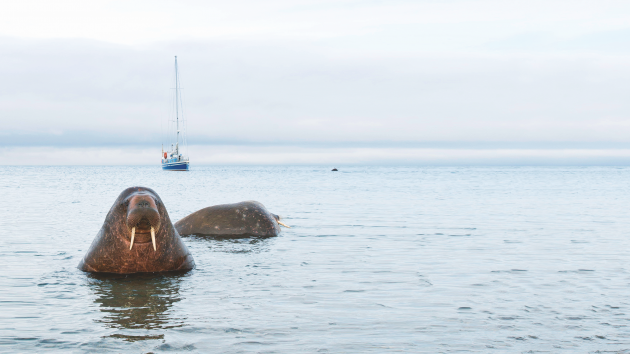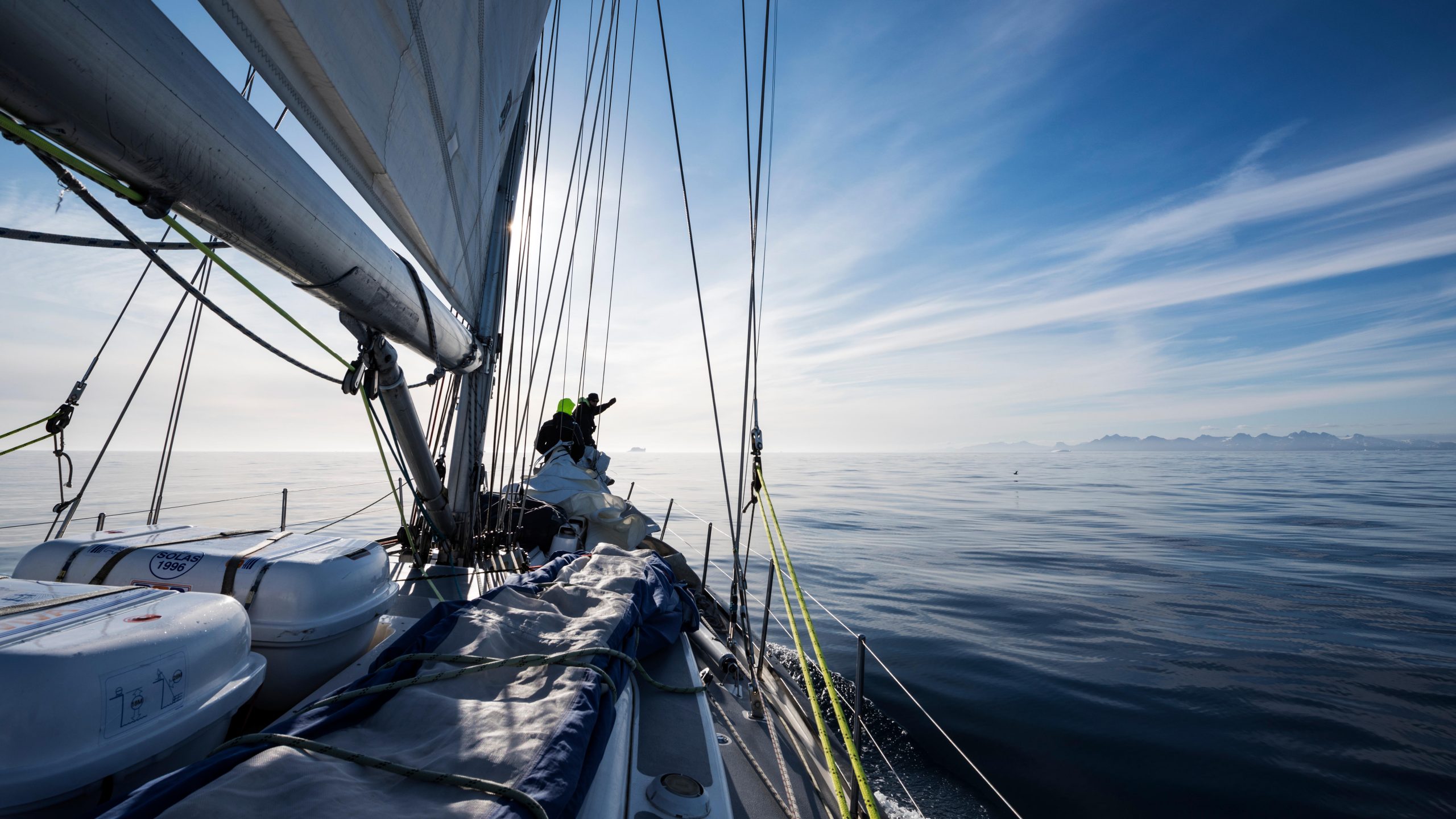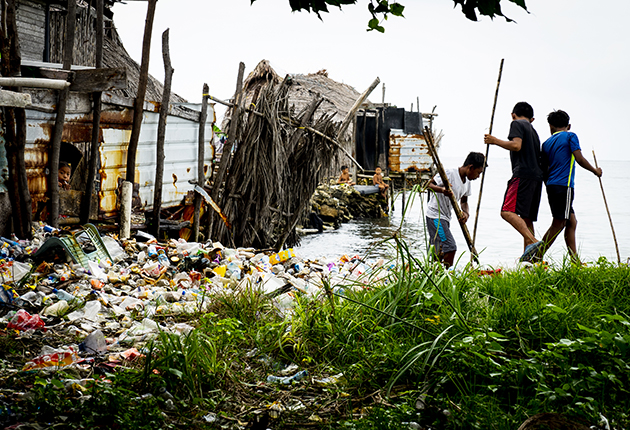Sam Shrives contends with sea ice and an amorous walrus during a three-month cruise from Norway across the Barents Sea to Svalbard. The article was runner-up in the 2021 Brian Black Memorial Award for marine environmental journalism
Sailing Svalbard: an Arctic education – Runner-up in the 2021 Brian Black Memorial Award for marine environmental journalism
The chill of the freezing air gnawed at my face as I gazed at the jigsaw of ice lying between our dinghy and the shore, the gentle hum of the outboard motor drowning out the normally serene quiet of the high Arctic, writes Sam Shrives.
We were navigating the growlers of Spitsbergen, the largest and only populated island of the Svalbard archipelago. Their sharp edges could easily puncture our dinghy.
Our Sweden 38, Cosmic Dancer V looked unnatural against the rugged snow-covered mountains and flowing glaciers that surrounded us.
We scanned the shore for danger to avoid an unwanted first meeting with the mascot for Glacier Mints, and pressed on.
The ground crunched underfoot as we pulled the dinghy up the beach.

Magdalenefjord inside the Northwest Spitsbergen National Park in Svalbard has many glaciers, including the Waggonway Glacier. Credit: Sam shrives
The bay was semi-circular, with sporadic rocks and an undulating grassy tundra beyond.
The shrill call of geese honked from just beyond the coarse sand but it was not them we’d come to see.
A whiff of rotting clams, like entering a Victorian fishmonger in July, drifted across the dunes. We turned to see the outline of a two-tonne mass of blubber and tusks basking about 400 metres further along.
As we approached, the stench hit us in waves but the walrus seemed nonplussed by our presence. A quick, apathetic glance was the best we got from the vast majority of these magnificent sea blimps, but the hulking size and large tusks ensured we kept our distance.
Though, as we gazed, one seemed to be transfixed on our skipper. ‘Looks like you’ve got a date for tonight,’ I posited. ‘Shut up,’ was the curt reply.
This flirtatious mammal, however, had clearly been catching up on the TV show Love Island and proceeded to start delicately rubbing her flipper against her stomach. Persisting, I upped the ante with: ‘Ah babes, she totes wants you as her beau, just shoot your shot’ (Love Island slang for giving up on pride and pursuing the person of your dreams).
Thoroughly unimpressed with my antics and with a mind on our next destination, our skipper curtly turned on his heel and marched back to the dinghy.

A flare gun can be useful for keeping the inquisitive wildlife of Svalbard at bay. Credit: Sam Shrives
Not wanting to risk jousting with a pair of metre-long tusks, I quickly scampered after him.
After launching the dinghy, we once again zig-zagged through the ice, the skipper intent on delivering us safely back on board while I postulated on the beautiful Disney love story it could have been.
Unfortunately, the tension was about to rise. As we had one last look at the beach, our basking bachelorette huffed and puffed to the water’s edge and, gliding in with more grace than a Tom Daley gold-medal winning dive, began to give chase. Now this was no joke.
If our newly acquired friend decided to board us for some impromptu speed-dating it could easily sink the dinghy, and cause serious injury to ourselves.
Grim-faced, I kept track of her bobbing head. Luckily, we reached the yacht’s stern before being intercepted. After almost being trapped in the strangest love triangle in sailing history, I was famished. We all enjoyed a hearty breakfast before planning for our next visit.
After raising the kelp-caked anchor we set sail.
In the land of the midnight sun where it is light for 24 hours a day during the summer months, time becomes almost meaningless.
Like ancient foragers we slept when we were tired, ate when we were hungry and kept track of days rather than hours and minutes.
It was something we became accustomed to during our three-month voyage, which took us from Haugesund in Norway to Spitsbergen, the biggest island in Svalbard before returning to the Norwegian city of Tromsø above the Arctic Circle.
Human impact on Svalbard
A pleasant potter in 8-10 knots of breeze took us round the headland to Isfjord. This expansive fjord is the second biggest in Spitsbergen, framed by jagged rippled peaks on one side and the familiar green of Arctic vegetation on the other.
As we cruised, our destination became ever clearer: a black spot on the untouched landscape. We were heading to the coal mine of Barentsburg.
Even in the era of global warming, I sometimes find it challenging to visualise the environmental impact humans are having on the planet.
This is impossible when gazing upon the sprawl of industrial machinery and slag imprinted on the hillside.
What would normally be a sight barely worth noting had a harsh impact when so far from civilisation.
It struck me as a microcosm of the urgent need for global change and a rethink of traditional practices.

In the summer and autumn in Svalbard, walrus can often be found relaxing on beaches rather than their usual ice floes. Credit: Sam Shrives
As we approached, the town loomed above us, the mine on the right in contrast to the mix of flats and more traditional buildings of various colours.
Barentsburg has had an operational mine since 1920. It was originally Dutch controlled before being acquired by Russia in 1932.
From a heyday of over 1,000 people living and working, it was down to 455 in 2020. Both Norway and Russia have mining operations on Spitsbergen, although Norway has announced it will stop coal mining by 2028.
Continues below…
Sailing in the Arctic: how to cruise to the far north
Once you’ve experienced the beauty and peace of sailing in the Arctic, you’ll want to return again and again. Andrew…
New Brian Black Memorial Award for marine environmental journalism
Yachting Monthly has launched a new journalism award in memory of Brian and Lesley Black, which aims to recognise the…
Polluted Paradise: Brian Black Memorial Award winner for 2021
Sophie Dingwall sees firsthand the impact of plastic pollution on the Caribbean's population. Her article - Polluted Paradise - has…
B&G sponsor Yachting Monthly marine environmental journalism award
Marine electronics company B&G announces sponsorship of the Brian Black Memorial Award for marine environmental journalism, with £3,000 and other…
After securing the boat, we began the ascent up a well-kept wooden staircase leading to the main square, briefly pausing to read ‘Welcome to Hell’ etched into a post.
After huffing up the winding staircase, we were greeted by a stone square with seemingly abandoned wooden huts on the left and a large gym or swimming pool on the right.
A short walk further revealed a large stone bust of Lenin, his piercing gaze seemingly following you at every angle.
A crew member commented it would make a cracking souvenir, but considering we’d never be able to fit it down below, strapping it to the bow was not the most sensible of options.
We wandered amongst the buildings with a slight sense of unease, taking in that quiet atmosphere you find only when a whole town is busy in a single line of work.

Coal has been mined at Barentsburg since 1921. The mine has been owned by the Russian state since 1932. Credit: Sam Shrives
Past a few more Soviet-era monuments and a tiny wooden church, you quickly come to the far end of the town and the entrance to the mine.
There couldn’t be a bigger contrast with the pristine plastic and pollution-free beach we’d encountered that morning.
It was unsettling to see such an otherwise untouched environment stained by industry.
It seemed so out of place with the surroundings where, despite the harshness of the weather, life is abundant.

Norway to Svalbard and back. Credit: Maxine Heath
We’d heard about the rapidly receding glaciers and rising temperatures, but this was a literal black-and-white example of the environment being spoiled for human gain.
Looking back I am reminded of the David Attenborough quote: ‘No one will protect what they don’t care about, and no one will care about what they have never experienced.’
Whether it’s a coal mine in Svalbard or pollution in UK rivers, unless we connect people with the natural world, collective action for change is not possible.
Education and access to nature are key to tackling climate change. Wandering back, we discussed plans to push north and try and spot the king of the bears.
The power of nature
At 80° north, I stood on the bow totally engrossed by the sheer power and predatory beauty of a polar bear on a nearby headland.
This serenity proved short-lived, though, as an agitated conversation emitted from the cockpit; my skipper was in a calm, yet panic-tinged discussion with the boat’s co-owner about the engine failing to start.
I gazed at the small, rocky natural harbour we had moored in, as sea ice marched slowly yet menacingly towards our fragile vessel from seaward.
A minute passed, the deadly silence only broken by the sporadic spluttering of the engine and a slow screech as two large sheets of ice ground against each other.

The Peter Norlin-designed Sweden 38, Cosmic Dancer V has been extensively refitted for high latitude sailing. Credit: Sam Shrives
The situation was getting desperate. ‘We need some long poles to fend off the ice,’ said the skipper.
Thankful for something to do, I sprang into action; a short search through the lockers saw me triumphantly return to deck waving a mop and boat hook. I lay on the deck, brandishing my mop in hand like a sword ready to repel boarders.
The minutes ticked by and the ice surrounded us. By now the fourth crew member had joined me but try as we might, we were struggling to contain the full force of nature with just two poles and human strength; it was a David and Goliath contest.
There can’t be many sounds as bad as ice scraping against fibreglass.
The battle continued for a few minutes but we were clearly losing. The skipper continued to shout encouragement as he explored different methods to turn on the engine.
Just when he must have been getting desperate, the splutter seemed to linger for a second; another turn of the key and the engine roared into life.

At 80° north in Svalbard. Credit: Sam Shrives
We pushed ice from the yacht sides as the skipper threw the throttle into reverse. Under full revs, we bulldozed our way to freedom.
As we chugged away I reflected on how quickly seemingly calm situations can turn perilous. I turned and grinned as the engine spluttered to a halt again.
My education in the Arctic went beyond learning to live on a yacht and function in a cold environment.
It taught me how vulnerable we are and the disconnect most of us have with our place in the natural world. Despite planning for every eventuality, a potential disaster may be just around the corner, be that getting stuck in a harbour filling with ice or escaping an aberrant walrus.
Mainly, though, it taught me the responsibility each of us has to protect the natural world, how life for animals in extreme environments is only going to become more challenging.
I just hope we can act fast enough so Wally the Walrus and his offspring can survive and thrive.
Brian Black Memorial Award sponsored by B&G

Brian Black, a television journalist and lifelong sailor and contributor to Yachting Monthly, was as passionate about the marine environment as he was eloquent in his writing and filmmaking about the crises facing fragile Arctic ecosystems.
His wife Lesley was a sailor and author in her own right, becoming Northern Ireland’s first female yacht club commodore.
As a memorial to Brian and Lesley Black, the Black family, in conjunction with YM, established an award to celebrate sailing adventures which shed a fresh light on marine environmental issues through inspiring journalism.
The award aims to recognise the very best writing about the marine environment that brings a new perspective to readers.

The award is sponsored by marine electronics company B&G, which recognises sustainability as one of the pillars of its multi-year strategy.
B&G’s sustainability agenda includes: removing all single- use plastics from its packaging and using only recyclable materials from this year; reducing company air travel by 90%; reducing paper used in their offices by 95%; and decreasing energy consumption for IT equipment from 305,000kWh to 250,000kWh.
It is also working with sister company C-Map to open up their BioBase platform, which processes, maps and stores spatial aquatic data free of charge to government bodies and research institutes, to support aquatic conservation. www.bandg.com
For more details on the Brian Black Memorial Award visit: www.yachtingmonthly.com/brianblack







